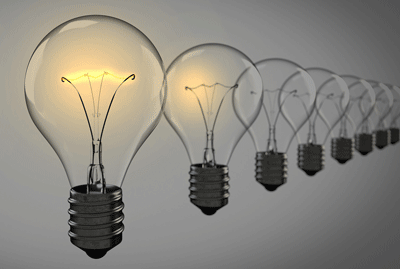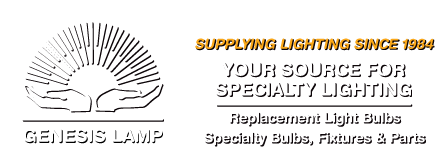History and Evolution of the Light Bulb
 Ask anybody who invented the light bulb, and they would probably be quick to tell you that it was Thomas Alva Edison. They would be technically incorrect. He was the patent holder for the electric light and he did advance the technology considerably, but the story of the light bulb actually goes back much further and starts with somebody you've probably never heard of.
Ask anybody who invented the light bulb, and they would probably be quick to tell you that it was Thomas Alva Edison. They would be technically incorrect. He was the patent holder for the electric light and he did advance the technology considerably, but the story of the light bulb actually goes back much further and starts with somebody you've probably never heard of.
Humphry Davy is believed to have invented the first electric light in 1802, a device called the Electric Arc Lamp. In his experiments with electricity, he was able to invent an electric battery, which he connected to a piece of carbon using wires. The carbon glowed when it was electrified, producing a very bright light for a short period of time. This was the beginning of a long road of experiments, successes and failures with electric lighting that would span the next two centuries and still continues today.
Over the next 70 years, more and more inventors created light devices and light bulbs, with varying degrees of success. One major technological advance occurred in 1840 when Warren de la Rue, a British scientist, put a coiled platinum filament inside a sealed vacuum tube and attached it to an electric current. He used platinum because it has a higher melting point, so it can stay intact even when the temperature became extremely hot. The platinum was placed in the vacuum tube because there would be fewer gas molecules in that space to react with the platinum and break it down, so the unit would last longer. If it weren't for the fact that platinum was so expensive, this design was efficient enough to have been commercially viable.
Ten years later, a physicist in England named Joseph Wilson Swan enclosed carbonized paper filaments in a glass tube, creating a light bulb in a more modern sense of the term. He worked on his design for ten years, producing a working prototype in 1860. The problem was that without the vacuum, the bulb just didn't last long enough to be used in any practical lighting application. Swan kept at it, trying to perfect his design, and he was helped along when vacuum pump technology began to improve in the 1870's. By using a filament made of a treated cotton thread, he finally was able to develop a longer-lasting light bulb. The new filament also kept the bulb from getting blackened as the filament burned.
In 1874, Henry Woodward, a medical electrician, and his colleague, Mathew Evans, filed for a Canadian patent for electric lamps. Their units were made with electrodes holding varying sizes and shapes of carbon rods between them in nitrogen-filled glass cylinders. They were never able to make their lamps a commercial success, however, and they decided to sell their patent in 1879 to Thomas Edison.
Thomas Edison had begun serious research into developing a practical incandescent lamp in 1878. On October 14 of that year, he filed his first application for a patent for "Improvement In Electric Lights". He was struggling with the metal filament material, however, and he kept trying different materials to improve on the filament from his original design. On Nov 4, 1879, Edison filed for another U.S. patent. This time, it was for an electric lamp with "a carbon filament or strip coiled and connected ... to platina contact wires." The patent included several options for creating the carbon filament including with "cotton and linen thread, wood splints, papers coiled in various ways," but it would be several months after the granting of the patent before Edison and his team found that a carbonized bamboo filament was capable of lasting more than 1,200 hours. This opened to door to the commercial production of light bulbs that could actually be used in practical applications. The Edison Electric Light Company, Thomas Edison’s company, opened in 1880.
In the early 1900's, more advancements in lighting technology came, starting with the introduction of tungsten filaments in 1906. Edison had believed that tungsten would make the best filaments for light bulbs, but the technology of his day was not sufficient to make a piece of tungsten fine enough to be used as a filament. The General Electric Company patented a method of manufacturing filaments made of tungsten for incandescent light bulbs in 1906. William David Coolidge, working for the company in 1910, found a way to make the filaments last even longer through an improved manufacturing process.
The 1920's and 1930's saw the arrival of specialty light bulbs. Frosted light bulbs and bulbs with adjustable power (for use in neon lighting and car headlights) came out in the twenties, while the fluorescent tanning lamp and the creation of photographic flashbulbs came in the thirties. Further refinements came in the 1940's and 1950's with the creation of "soft light" incandescent light bulbs, quartz glass bulbs and halogen light bulbs.
From the 1960's on, improvements to the light bulb were all about performance. In the sixties and seventies, bulbs become brighter, thanks to better mirrors and ellipsoid reflectors. The eighties brought low wattage metal halides. The nineties saw some of the biggest innovation in 90 years, starting with the magnetic induction light bulb (with an amazing life expectancy of 60,000 hours or more), environmental advancements like the compact fluorescent and full spectrum light bulbs also pushed the technology forward.
Now there are several choices of light bulbs available, from incandescent to fluorescent to LED. Surprisingly, incandescents are still among the most popular light bulbs, even with all the new choices available. Modern incandescents haven't come that far from Edison's early efforts--the bulbs still convert less than 10 percent of the energy to light. Why are they still so popular then? They're cheap, they come in a variety of sizes, and they don't require much voltage. Now they are starting to be phased out, however, as countries like the U.S. start creating legislation to push people toward more environmentally friendly and efficient lighting options. You can bet that future light bulbs will have a lower environmental impact.
